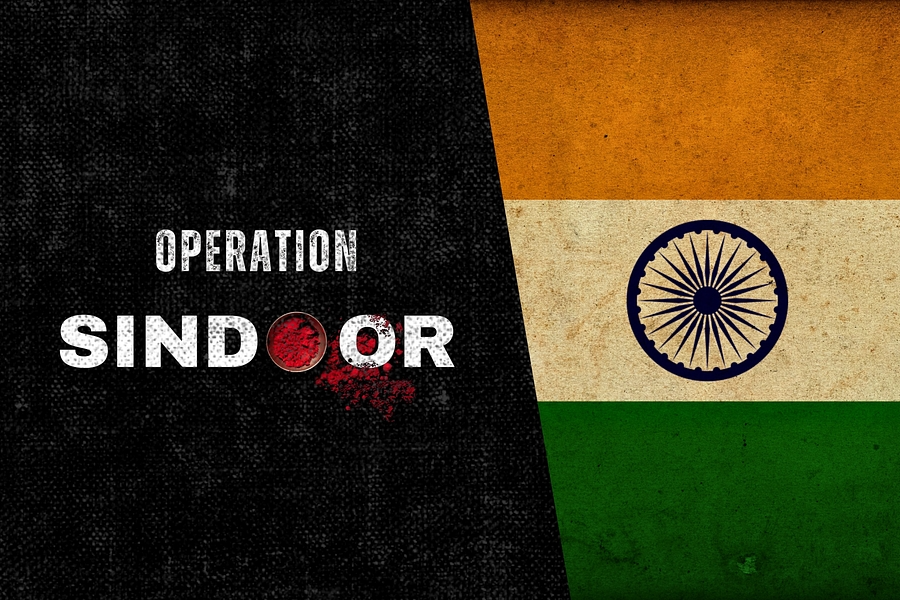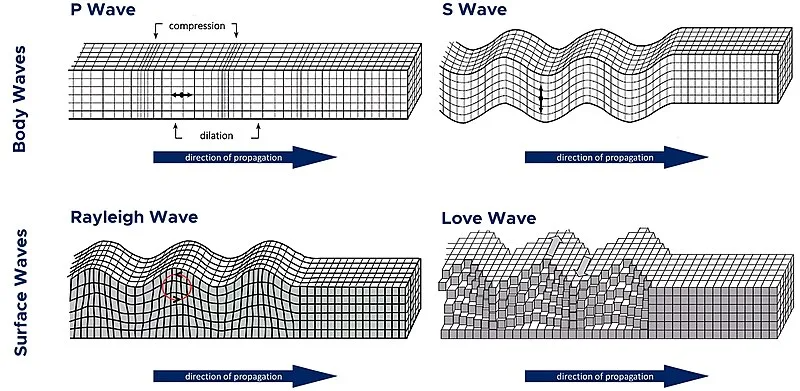September 30th Current Affairs
Table of Contents
Kannada Literature Optional Syllabus
Home / ಐಚ್ಚಿಕ ಕನ್ನಡ ಸಾಹಿತ್ಯದ ಪಠ್ಯಕ್ರಮ ಐಚ್ಚಿಕ ಕನ್ನಡ ಸಾಹಿತ್ಯ ಪತ್ರಿಕೆ – 1 ವಿಭಾಗ – ಎ ಅ) ಕನ್ನಡ ಭಾಷೆಯ ಚರಿತ್ರೆ ಭಾಷೆ
UPSC Current Affairs – October 6th
October 06th Current Affairs Home / Table of Contents 36-hour curfew imposed in parts of Odisha’s Cuttack over communal tensions
Religious Minorities in India and the Challenge of Communal Harmony: A Sociological Reflection on the Cuttack Violence
Home / Religious Minorities in India and the Challenge of Communal Harmony: A Sociological Reflection on the Cuttack Violence Sociology
UPSC Current Affairs – October 4th
October 04th Current Affairs Home / Table of Contents Isabgol Processors threaten to halt purchases from October 6th over GST
Sologamy and Contemporary Trends in Marriage: A Sociological Perspective
Home / Sologamy and Contemporary Trends in Marriage: A Sociological Perspective Sociology Paper 1: Systems of Kinship – Contemporary trends
UPSC Current Affairs – October 3rd
October 03rd Current Affairs Home / Table of Contents NASA IMAP to show how solar particles are energised and shield
Understanding Indian Festivals through Durkheim: Religion, Rituals, and Collective Conscience
Home / Understanding Indian Festivals through Durkheim: Religion, Rituals, and Collective Conscience Sociology Paper 1: Émile Durkheim – Religion and
UPSC Current Affairs – September 30th
September 30th Current Affairs Home / Table of Contents Ladakh groups reject talks with government, Ministry says open to dialogue
Caste Census in India: A Sociological Perspective
Home / Caste Census in India: A Sociological Perspective Sociology Paper 2: Caste System – Features of Caste system. The
Constitutional Morality: Upholding India’s Democratic Ethos
Home / Constitutional Morality: Upholding India’s Democratic Ethos Sociology Paper 2: Visions of Social Change in India – Constitution, law,
Ladakh groups reject talks with government, Ministry says open to dialogue
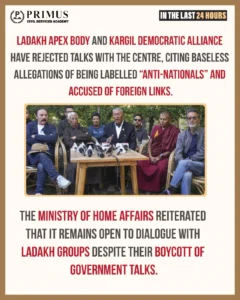
Relevance to UPSC
General Studies Paper II:Polity & Governance
- Federalism and Autonomy: The article discusses demands for statehood and Sixth Schedule status for Ladakh, highlighting issues related to federal governance and autonomy within the Indian Union.
- Role of Civil Society: It illustrates the involvement of civil society organizations like the Leh Apex Body (LAB) and Kargil Democratic Alliance (KDA) in advocating for political rights and engaging with the central government.
- Public Order and Security: The article touches upon the implications of protests and unrest in Ladakh, raising questions about maintaining public order and the state’s response to civil disturbances.
General Studies Paper III: Internal Security
Security Concerns: Need to address security issues in a sensitive border region, emphasizing the importance of maintaining peace and stability in Ladakh.
More About the News
- On 24 September 2025, protests in Leh over statehood and Sixth Schedule demands resulted in 4 deaths and 50+ injuries.
- Ministry of Home Affairs (MHA) expressed willingness to engage with Leh Apex Body (LAB) and Kargil Democratic Alliance (KDA), stressing restoration of normalcy first.
- Preparatory meeting with Ladakh leaders, initially on 27 September, deferred to 29 September following activist Sonam Wangchuk’s arrest.
Pressure Groups
Pressure groups are organized entities that seek to influence public policy and decision-making without directly seeking political office. They play a crucial role in modern democracies by representing the interests of specific sections of society and providing feedback to the government. In the future, their role is likely to expand in shaping policies on emerging issues such as climate change, digital governance, and social justice.
Features of Pressure Groups
- Represent specific interests rather than general political ambitions
- Seek to influence policy without contesting elections
- Organized structure with formal leadership
- Utilize various methods of advocacy (lobbying, media campaigns, protests)
- Aim for policy change, social awareness, or protection of rights
Types of Pressure Groups
- Economic/Industrial Groups: Represent business interests
- Example: Confederation of Indian Industry (CII), FICCI
- Example: Confederation of Indian Industry (CII), FICCI
- Professional/Occupational Groups: Represent professions
- Example: Indian Medical Association (IMA), Bar Council of India
- Example: Indian Medical Association (IMA), Bar Council of India
- Environmental Groups: Advocate for ecological issues
- Example: Greenpeace India, World Wildlife Fund (WWF)
- Example: Greenpeace India, World Wildlife Fund (WWF)
- Social/Cultural Groups: Represent social or cultural interests
- Example: All India Democratic Women’s Association (AIDWA)
- Example: All India Democratic Women’s Association (AIDWA)
- Single-issue Groups: Focus on one major cause
- Example: Right to Information (RTI) campaign groups
- Example: Right to Information (RTI) campaign groups
- Political/Ideological Groups: Influence policy on ideological grounds
- Example: Indian Youth Congress
Methods Employed by Pressure Groups
- Lobbying: Direct persuasion of legislators
- Example: FICCI lobbying for industrial policy reforms
- Example: FICCI lobbying for industrial policy reforms
- Public Campaigns & Demonstrations: Awareness or protest actions
- Example: Farmers’ protests led by Samyukt Kisan Morcha
- Example: Farmers’ protests led by Samyukt Kisan Morcha
- Litigation/Public Interest Litigation (PIL): Legal intervention
- Example: Environmental groups filing PILs in Supreme Court for river pollution
- Example: Environmental groups filing PILs in Supreme Court for river pollution
- Media Advocacy: Using social media, TV, or newspapers
- Example: Greenpeace campaigns against plastic pollution
- Example: Greenpeace campaigns against plastic pollution
- Research & Policy Papers: Providing expertise to influence policies
- Example: CII & NITI Aayog collaborative reports on industry reforms
Positive Outcomes of Pressure Groups
- Policy Influence: Aid government in formulating policies
- Example: IMA influencing health policy reforms
- Example: IMA influencing health policy reforms
- Social Awareness: Raise awareness on crucial issues
- Example: Greenpeace campaigns on climate change
- Example: Greenpeace campaigns on climate change
- Protection of Minority Interests: Safeguard marginalized communities
- Example: AIDWA advocating for women’s rights
- Example: AIDWA advocating for women’s rights
- Expert Consultation: Provide technical expertise to policymakers
- Example: CII reports aiding industrial policy decisions
- Example: CII reports aiding industrial policy decisions
- Democratic Participation: Encourage citizen engagement in governance
- Example: RTI activists promoting transparency in government
Limitations of Pressure Groups
- Elite Domination: Often dominated by wealthy or powerful groups
- Example: Big industrial lobbies influencing tax reforms over public interest
- Example: Big industrial lobbies influencing tax reforms over public interest
- Partial Representation: Represent narrow interests, not the broader public
- Example: Factional farmer groups ignoring smallholders’ interests
- Example: Factional farmer groups ignoring smallholders’ interests
- Conflict Generation: Can create policy conflicts or delays
- Example: Divergent environmental vs. industrial lobbying delaying projects
- Example: Divergent environmental vs. industrial lobbying delaying projects
- Excessive Political Influence: Risk of corrupt lobbying practices
- Example: Alleged corporate lobbying for favorable policies in India
- Example: Alleged corporate lobbying for favorable policies in India
- Lack of Accountability: Not directly accountable to public
- Example: Some NGO-led campaigns with opaque funding sources
Recommendations by Popular Committees
- Second Administrative Reforms Commission (2007): Suggested transparency in lobbying activities
- Sarkaria Commission: Recommended regulation of interest groups to prevent undue influence on policy
Best Practices
Global:
- Lobbying transparency registers in EU and USA
- Public consultation frameworks in Canada for policy formulation
Way Forward
- Strengthen the legal framework for transparency in lobbying
- Encourage inclusivity and representation of marginalized sections
- Promote ethical advocacy and research-backed campaigns
- Institutionalize mechanisms for citizen feedback in policymaking
Pressure groups are vital in bridging the gap between citizens and the state, ensuring diverse voices are heard in policymaking. With increasing complexity of governance, their role in shaping informed, evidence-based, and socially responsive policies will only grow. Proper regulation and ethical practices can enhance their contribution to India’s democratic and developmental goals.
Prelims MCQ
Q. Which of the following statements about pressure groups is/are correct? 1. They aim to influence policy but do not directly seek political office. 2. They always represent the interests of the majority population. 3. They can use public campaigns, lobbying, and litigation as methods.
A. 1 and 2 only
B. 2 and 3 only
C. 1 and 3 only
D. All of the above
Mains Question
Q. Critically examine the role of pressure groups in India’s democracy. Discuss their contribution to policymaking, the challenges they pose, and suggest measures to ensure their ethical and inclusive functioning.
India-EFTA Trade Deal to Launch October 1 After Long Delay
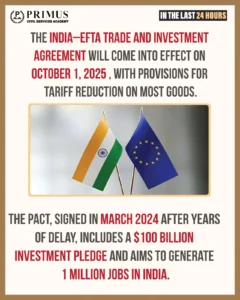
Relevance to UPSC
General Studies Paper II: International Relations
- Trade Diplomacy & Balancing India’s interests with the global partners.
General Studies Paper III: Economy
- Bilateral Trade & Investments
- Integration of the Global Economy
More About the News
- The India–EFTA TEPA, effective from October 1, 2025, is India’s first trade agreement with a European bloc, comprising Switzerland, Norway, Iceland, and Liechtenstein.
- The agreement includes tariff reductions on 80–85% of goods imported from EFTA countries, while nearly 99% of Indian exports will have duty-free access to these markets.
- EFTA nations have committed to investing $100 billion in India over 15 years, aiming to create 1 million direct jobs, particularly in manufacturing, green energy, and pharmaceuticals.
Types of Trade Agreements
Trade agreements are formal arrangements between countries that govern the exchange of goods, services, and investments. They aim to reduce trade barriers, enhance economic cooperation, and promote global integration. In the future, trade agreements will play a crucial role in shaping sustainable development, technology transfer, and regional economic stability.
Need for Trade Agreements
- Reduce tariffs and non-tariff barriers to facilitate free trade.
- Promote economic growth and boost exports and imports.
- Strengthen diplomatic and economic ties between countries.
- Encourage foreign investment and access to new markets.
- Harmonize standards and regulations to facilitate cross-border trade.
Types of Trade Agreements, Features, Advantages & Disadvantages
Type of Trade Agreement | Features | Advantages | Disadvantages | Example |
Free Trade Agreement (FTA) | Eliminates tariffs on most goods between member countries; members retain individual trade policies with non-members | Promotes trade and market access; reduces prices for consumers | Can harm domestic industries unable to compete; trade diversion risk | India-Singapore FTA |
Customs Union (CU) | FTA + common external tariff on non-members | Simplifies trade; prevents trade deflection | Requires coordination of external tariffs; loss of independent trade policy | European Union (EU) Customs Union |
Common Market (CM) | CU + free movement of factors of production (capital, labor) | Enhances labor mobility; integrated economic policy | Complex governance; regulatory harmonization challenges | European Single Market |
Economic Union (EU) | CM + common monetary and fiscal policy | Deeper economic integration; stronger global economic presence | Sovereignty concerns; policy coordination challenges | European Union (EU) |
Preferential Trade Agreement (PTA) | Reduces tariffs on selected products | Encourages incremental trade liberalization | Limited impact; may cause trade diversion | India-MERCOSUR PTA |
Bilateral Trade Agreement (BTA) | Agreement between two countries | Tailored benefits; easier negotiation | May exclude other partners; potential imbalance | India-Japan CEPA (Comprehensive Economic Partnership Agreement) |
Multilateral Trade Agreement (MTA) | Agreement among multiple countries | Broad market access; global cooperation | Complex negotiations; enforcement challenges | WTO Agreements (GATT, TRIPS) |
Prelims MCQ
Q. Consider the following statements regarding trade agreements: 1. A Customs Union requires a common external tariff on imports from non-member countries. 2. A Free Trade Agreement always involves the harmonization of monetary and fiscal policies. 3. Preferential Trade Agreements reduce tariffs on selected products among member countries.
A. 1 and 2 only
B. 2 and 3 only
C. 1 and 3 only
D. All of the above
Mains Question
Q. Examine the role of different types of trade agreements in promoting India’s economic growth. Analyze their benefits, challenges, and suggest strategies for maximizing the advantages while mitigating risks in the global trade environment.
A decade among the stars: India’s first space observatory AstroSat completes 10 years
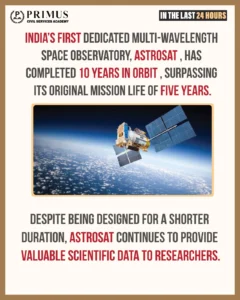
Relevance to UPSC
General Studies Paper 3: Science and Technology
- AstroSat’s 10-year milestone underscores India’s advancements in space technology, highlighting the nation’s growing capabilities in space exploration and research.
- Global scientific knowledge, India’s active participation in international scientific collaborations.
- Effectiveness and sustainability of India’s space missions.
More About the News
- AstroSat, India’s first dedicated multi-wavelength space observatory, completed 10 years in orbit on September 28, 2025, surpassing its initial 5-year mission lifespan.
- It has provided significant insights into cosmic phenomena, including black holes, neutron stars, and distant galaxies, contributing to over 3,400 research publications globally.
- The mission exemplifies successful international collaboration, with contributions from institutions in Canada, the UK, and India, and continues to operate with all five onboard instruments fully functional.
AstroSat
AstroSat is India’s first dedicated multi-wavelength space observatory, launched in 2015 by ISRO. It enables simultaneous observation of the universe in optical, ultraviolet, and X-ray bands, thereby advancing India’s capabilities in high-energy astrophysics. The mission reflects India’s commitment to scientific research and space-based exploration for understanding cosmic phenomena.
AstroSat: Overview
- AstroSat is India’s first dedicated multi-wavelength space observatory launched by ISRO.
- Launched on September 28, 2015, using the PSLV-C30 rocket from Sriharikota.
- It enables simultaneous observation in optical, ultraviolet, and X-ray wavelengths.
Objectives of AstroSat
- To observe the universe in multiple wavelengths simultaneously.
- To study cosmic sources like stars, galaxies, black holes, and neutron stars.
- To complement ground-based telescopes by providing high-precision space-based observations.
- To support research in high-energy astrophysics and stellar evolution.
Developed By
- Developed and managed by the Indian Space Research Organisation (ISRO).
- Collaborations with Indian universities and research institutions for payload development and data analysis.
Important Instruments on AstroSat
- UVIT (Ultra-Violet Imaging Telescope): Observes in far-UV, near-UV, and visible light.
- LAXPC (Large Area X-ray Proportional Counter): Measures X-ray emissions in 3–80 keV range.
- SXT (Soft X-ray Telescope): For imaging and spectroscopy in soft X-rays (0.3–8 keV).
- CZTI (Cadmium Zinc Telluride Imager): Detects hard X-rays (10–150 keV) and gamma-ray bursts.
- SSM (Scanning Sky Monitor): Monitors X-ray sky for transient sources.
Important Observations Made
- Discovery of highly magnetized neutron stars and pulsars.
- Insights into black hole binaries and their X-ray emission patterns.
- Observations of active galactic nuclei and distant galaxies.
- Detection of ultraviolet emission from star-forming regions.
- Contribution to over 3,400 research publications globally.
Technical Highlights of the Mission
- Multi-wavelength observations simultaneously for the first time in India.
- Orbit: 650 km, near-Earth, circular orbit with inclination 6°.
- Mission life was initially planned for 5 years, but is operational for over 10 years.
- High temporal resolution instruments for monitoring transient cosmic events.
- Compact and cost-effective design compared to similar international missions.
Learnings from AstroSat
- Strengthened India’s capabilities in space-based astrophysics research.
- Provided experience in building complex payloads and multi-instrument integration.
- Demonstrated long-term operational reliability in space.
- Encouraged international collaborations and scientific partnerships.
- Provided a foundation for future astrophysics missions like XPoSat.
Similar Missions by Other Countries
Mission | Country/Agency | Objective/Highlights |
Hubble Space Telescope | USA (NASA & ESA) | Multi-wavelength astronomy, optical & UV imaging |
Chandra X-ray Observatory | USA (NASA) | High-resolution X-ray imaging, study of black holes & supernovae |
XMM-Newton | Europe (ESA) | X-ray spectroscopy & imaging of cosmic sources |
Swift | USA (NASA) | Detection of gamma-ray bursts and follow-up observations |
GALEX | USA (NASA) | Ultraviolet imaging of galaxies and star formation |
Hitomi | Japan (JAXA) | X-ray spectroscopy of galaxy clusters (briefly operational) |
HXMT (Insight) | China (CNSA) | Hard X-ray and gamma-ray monitoring of cosmic sources |
AstroSat’s success lays the foundation for India’s next-generation space observatories and deep-space missions. Its multi-wavelength observations will continue to enhance our understanding of black holes, neutron stars, and distant galaxies. In the future, such missions will foster international collaboration and strengthen India’s role in global astrophysics research.
Prelims MCQ
Q. Consider the following statements about AstroSat:
1. AstroSat is India’s first dedicated multi-wavelength space observatory.
2. It was launched using the GSLV Mk III rocket.
3. UVIT, LAXPC, and CZTI are some of its primary instruments.
A. 1 and 2 only
B. 1 and 3 only
C. 2 and 3 only
D. All of the above.
Statement 1 : AstroSat is India’s first multi-wavelength observatory. Statement 2 : It was launched using PSLV-C30, not GSLV Mk III. Statement 3 : UVIT, LAXPC, and CZTI are key instruments.
Mains Question
Q. Examine the significance of India’s AstroSat mission in the context of multi-wavelength astronomy. Discuss its contributions to astrophysical research, technological advancements, and India’s position in global space science.
RBI permits banks to grant working capital loans to manufacturers using gold as raw material
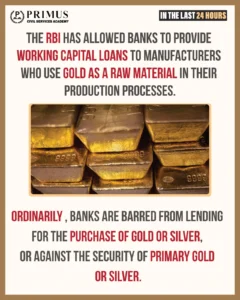
Relevance to UPSC
General Studies Paper III: RBI, Monetary Policy & Banking System
- This policy initiative by the RBI aims to enhance liquidity and financial accessibility for manufacturers in the gold processing sector, thereby promoting industrial growth.
- By facilitating working capital loans, the RBI intends to support the operational efficiency of businesses that rely on gold as a primary input, potentially boosting exports and employment in the sector.
- The move reflects the RBI’s role in implementing monetary policies that address sector-specific challenges and contribute to overall economic development.
More about the News
- The Reserve Bank of India has authorized banks to provide working capital loans to manufacturers who use gold as a raw material, aiming to improve liquidity in the gold processing sector.
- This move is expected to support the operational needs of businesses in the gold industry, potentially leading to increased production and export activities.
- The policy reflects the RBI’s proactive approach in addressing sector-specific financial challenges and promoting industrial growth.
Monetary Policy of RBI
The monetary policy of the Reserve Bank of India (RBI) is a key instrument for regulating the supply of money and credit in the economy. It aims to maintain price stability, support economic growth, and ensure financial stability. In the future, RBI’s monetary policy will increasingly focus on digital payments, inflation targeting, and balancing growth with macroeconomic stability.
Objectives of Monetary Policy
- Price Stability: Control inflation and maintain purchasing power.
- Economic Growth: Support investment, consumption, and employment.
- Financial Stability: Maintain stability in banking and financial systems.
- Liquidity Management: Ensure there is an adequate money supply in the economy.
- Balance of Payments Stability: Support external sector stability.
Importance of Monetary Policy
- Ensures economic stability by controlling inflation and deflation.
- Supports sustainable growth by regulating credit flow.
- Helps in employment generation indirectly via economic growth.
- Promotes financial discipline among banks and financial institutions.
- Acts as a tool for counter-cyclical measures during recessions or booms.
Impacts of Monetary Policy
- On Inflation: Tight policy reduces inflation; loose policy may increase it.
- On Credit Availability: Influences lending rates, investment, and consumption.
- On Exchange Rate: Affects foreign capital inflows and currency stability.
- On Economic Growth: Stimulates or restrains demand and output.
- On Employment: Indirect impact via growth in production and services.
Types of Monetary Policy & Features
Type | Features |
Expansionary/Accommodative | Increases money supply and lowers interest rates to stimulate growth. |
Contractionary/Restrictive | Reduces money supply or raises rates to control inflation. |
Neutral/Moderate | Maintains balance between growth and inflation. |
Credit Rationing Policy | Controls allocation of credit to specific sectors. |
Monetary Policy Committee (MPC)
- Constitution: 6 members (3 RBI officials, 3 government nominees).
- Objective: Fixing a policy repo rate to achieve the inflation target.
- Functions: Review economic and inflation trends, decide policy stance.
- Meetings: At least 4 times a year.
- Transparency: Minutes and voting records are published for accountability.
Types of Monetary Policy Tools & Features
Tool Type | Features | Example |
Quantitative (General) | Affects overall credit and liquidity | Repo rate, Cash Reserve Ratio (CRR), Statutory Liquidity Ratio (SLR) |
Qualitative (Selective) | Directs credit to specific sectors | Credit rationing, margin requirements, lending restrictions |
Conventional Tools | Standard instruments | Repo, reverse repo, CRR, SLR |
Non-Conventional Tools | Used during crises | Open market operations, LAF, MSF, Long-term repo, Targeted long-term repo operations (TLTRO) |
Limitations of Monetary Policy
- Time Lag: Policy effects take time to reflect in the economy.
- Liquidity Trap: Low interest rates may fail to stimulate demand.
- Dependence on Fiscal Policy: Monetary policy alone cannot drive growth.
- Structural Constraints: Inefficient markets and rigid labor policies limit impact.
- Inflation Targeting Challenges: External shocks (oil price, global crises) reduce effectiveness.
Way Forward
- Enhance coordination with fiscal policy for better outcomes.
- Focus on digital monetary tools and fintech integration.
- Strengthen forward guidance for interest rate expectations.
- Monitor global economic trends and capital flows for timely interventions.
- Improve financial literacy and credit access for inclusive growth.
RBI’s monetary policy remains a critical tool for ensuring macroeconomic stability and sustainable growth in India. With increasing digitalization and global interconnectedness, future policies will need to be more adaptive, transparent, and data-driven. Strengthening coordination with fiscal and structural reforms will enhance the overall effectiveness of monetary management.
Prelims MCQ
Q. Consider the following statements about the Monetary Policy of RBI:
1. The Monetary Policy Committee (MPC) has six members, with three from the RBI and three from the government.
2. Repo rate is a quantitative tool used to regulate money supply.
3. Monetary policy alone can ensure economic growth and employment without fiscal measures.
A. 1 and 2 only
B. 2 and 3 only
C. 1 and 3 only
D. All of the above
Statement 1 : MPC consists of 6 members (3 RBI + 3 govt). Statement 2 : Repo rate is a key quantitative tool. Statement 3 : Monetary policy alone cannot ensure growth, fiscal measures are also necessary.
Mains Question
Q. Critically examine the objectives, tools, and limitations of the Reserve Bank of India’s monetary policy. Suggest measures to enhance its effectiveness in ensuring price stability and promoting sustainable economic growth in the current economic scenario.
PM Modi welcomes Donald Trump’s Gaza peace plan
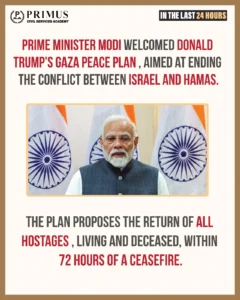
Relevance to UPSC
General Studies Paper II: International Relations
- This development highlights India’s active engagement in international diplomacy, reflecting its commitment to global peace and security.
- The support for the Gaza peace plan underscores India’s stance on conflict resolution and humanitarian issues in the Middle East.
- The involvement of multiple world leaders indicates a collective international effort towards addressing longstanding geopolitical conflicts.
More about the News
- Prime Minister Narendra Modi, along with other global leaders, have expressed support for a new peace initiative aimed at resolving the Gaza conflict.
- The plan focuses on establishing a ceasefire and facilitating humanitarian aid to the affected regions.
- India’s endorsement reflects its ongoing commitment to promoting peace and stability in the Middle East.
Trump’s Gaza Peace Plan 2025
U.S. President Donald Trump unveiled a 20-point peace plan aimed at resolving the ongoing Israel-Hamas conflict in Gaza. Supported by Israeli Prime Minister Benjamin Netanyahu, the plan envisions a comprehensive framework for ceasefire, reconstruction, and governance reforms. While Israel has endorsed the proposal, Hamas has yet to respond, leaving the plan’s future uncertain.
Key Features of the Plan
- Immediate Ceasefire: Calls for an immediate halt to hostilities between Israel and Hamas.
- Hostage Exchange: Demands the release of all Israeli hostages within 72 hours in exchange for 1,700 Palestinian detainees.
- Demilitarization of Gaza: Proposes the dismantling of Hamas’ military infrastructure and the establishment of a demilitarized zone.
- Transitional Governance: Suggests the creation of a technocratic Palestinian administration, overseen by an international “Board of Peace” led by Trump.
- Economic Development: Envisions Gaza as a special economic zone with international aid and infrastructure redevelopment.
- Amnesty and Safe Passage: Offers amnesty and safe passage to Hamas fighters willing to disarm and leave Gaza.
- International Monitoring: Proposes the establishment of an International Stabilization Force to ensure compliance and security.
The 21 Point Plan
- Immediate Ceasefire: All military operations between Israel and Hamas will cease immediately upon mutual agreement.
- Hostage and Prisoner Exchange: All Israeli hostages, both living and deceased, will be returned within 72 hours. In exchange, Israel will release 250 life-sentenced Palestinian prisoners and 1,700 detainees apprehended since October 7, 2023.
- Demilitarization of Gaza: All offensive weaponry and military infrastructure of Hamas will be destroyed. Hamas members who commit to peaceful coexistence and decommission their weapons will receive amnesty.
- Transitional Governance: A technocratic Palestinian administration will govern Gaza, excluding Hamas from any role in governance.
- International Oversight: An international “Board of Peace,” led by former U.S. President Donald Trump and including figures like Tony Blair, will oversee the implementation of the peace plan.
- Economic Development: A “Trump economic development plan” will be created to rebuild Gaza’s infrastructure, including water, electricity, sewage systems, hospitals, and bakeries.
- Humanitarian Aid: Humanitarian aid will be sent into Gaza immediately, with distribution managed by the United Nations and other international institutions.
- Special Economic Zone: A special economic zone will be established in Gaza, offering preferred tariff and access rates to participating countries.
- Freedom of Movement: Residents of Gaza will not be forced to leave; those who wish to leave will be free to do so and free to return.
- Demilitarization Process: A process of demilitarization will be implemented under the supervision of independent monitors, including the destruction of weapons factories and tunnels.
- Regional Guarantees: Regional partners will provide guarantees to ensure that Gaza poses no threat to its neighbors or its people.
- International Stabilization Force: An International Stabilization Force (ISF) will be deployed in Gaza to train and support Palestinian police forces and secure border areas.
- Israeli Withdrawal: Israel will not occupy or annex Gaza. As the ISF establishes control and stability, the Israel Defense Forces (IDF) will withdraw based on agreed standards, milestones, and timeframes.
- Implementation in Terror-Free Areas: In the event Hamas delays or rejects the proposal, aid and reconstruction efforts will proceed in areas of Gaza that are free from terrorist activities.
- Interfaith Dialogue: An interfaith dialogue process will be established to promote tolerance and peaceful coexistence between Palestinians and Israelis.
- Pathway to Palestinian Statehood: While not immediate, the plan envisions a credible pathway to Palestinian self-determination and statehood, contingent upon reforms by the Palestinian Authority.
- Dialogue Between Israel and Palestinians: The United States will facilitate a dialogue between Israel and the Palestinians to agree on a political horizon for peaceful coexistence.
- International Support for Reconstruction: International partners will support the reconstruction of Gaza’s infrastructure and economy.
- Monitoring and Verification: Independent monitors will verify compliance with the terms of the peace plan.
- Security Arrangements: Security arrangements will be put in place to prevent the re-emergence of militant activities in Gaza.
- Long-Term Commitment: All parties will commit to the long-term implementation of the peace plan, with regular reviews and adjustments as necessary.
Positives of the Plan
- Potential for Peace: Offers a structured approach to ending the conflict and establishing long-term peace.
- Humanitarian Focus: Addresses immediate humanitarian needs through hostage exchanges and civilian protection.
- Economic Opportunities: Promotes economic development and job creation in Gaza.
- Regional Cooperation: Encourages collaboration among Middle Eastern countries for a unified approach.
- International Involvement: Engages the international community in the peace process, enhancing legitimacy.
Challenges in Implementing the Plan
- Hamas’ Rejection: Uncertainty regarding Hamas’ acceptance of the terms, particularly disarmament and governance changes.
- Security Concerns: Potential resistance from hardline factions within Gaza and the broader region.
- International Coordination: Challenges in aligning the interests of various international stakeholders.
- Sovereignty Issues: Concerns over the imposition of external governance structures on Palestinian territories.
- Resource Allocation: Ensuring adequate funding and resources for reconstruction and development efforts.
Role of India in the Peace Process
- Diplomatic Support: India has welcomed the peace plan, recognizing it as a viable pathway to long-term peace.
- Advocacy for Palestinian Rights: Emphasizes the importance of a two-state solution and the protection of Palestinian sovereignty.
- Regional Influence: Utilizes its diplomatic relations with Middle Eastern countries to support peace initiatives.
- Humanitarian Assistance: Offers to provide humanitarian aid and support for reconstruction efforts in Gaza.
- Mediation Efforts: Potential to play a mediating role between conflicting parties, leveraging its neutral stance.
Impact on India
- Strategic Interests: Strengthens India’s position as a key player in Middle Eastern diplomacy.
- Economic Opportunities: Potential for increased trade and investment in the region.
- Security Concerns: Implications for regional security dynamics, particularly concerning Pakistan and China.
- Diaspora Relations: Impact on the Indian diaspora in the Middle East and their role in bilateral relations.
- Global Standing: Enhances India’s reputation as a proponent of peace and stability on the global stage.
India's Proposed Solution to the Israel-Gaza Conflict
- Two-State Solution: Advocates for the establishment of an independent and sovereign Palestinian state alongside Israel.
- International Mediation: Supports the involvement of international bodies, including the United Nations, in facilitating negotiations.
- Human Rights Focus: Emphasizes the protection of human rights and the provision of humanitarian aid to affected populations.
- Economic Cooperation: Encourages economic collaboration between Israel and Palestine to foster mutual development.
- Regional Dialogue: Promotes dialogue among Middle Eastern countries to address underlying issues and build trust.
Countries Supporting the Plan
- Israel: Endorsed the plan, viewing it as a step towards long-term peace.
- United States: Initiated and actively supports the plan, with Trump leading the peace efforts.
- Arab and Muslim Nations: Countries like Saudi Arabia, Qatar, and Egypt have expressed support, contingent on certain conditions being met.
- European Union: Generally supportive, advocating for a balanced approach and the protection of Palestinian rights.
- India: Expressed support, highlighting the plan’s potential for sustainable peace.
Countries Opposing the Plan
- Hamas: Has not accepted the plan, citing concerns over disarmament and governance changes.
- Iran: Opposes the plan, viewing it as a U.S.-led initiative that undermines Palestinian sovereignty.
- Hezbollah: Critical of the plan, perceiving it as a threat to regional resistance movements.
- Syria: Expresses reservations, fearing the plan may marginalize Palestinian interests.
- Russia: Cautious in its support, calling for inclusive negotiations and respect for international law.
Way Forward
- Inclusive Dialogue: Encourage all Palestinian factions, including Hamas, to participate in peace negotiations.
- International Support: Mobilize global support for reconstruction efforts and humanitarian aid.
- Monitoring Mechanisms: Establish robust mechanisms to ensure compliance with the terms of the peace plan.
- Confidence-Building Measures: Implement steps to build trust between Israel and Palestine, such as prisoner exchanges and ceasefire agreements.
- Long-Term Commitment: Ensure sustained international engagement to address underlying issues and prevent future conflicts.
Trump’s Gaza Peace Plan 2025 presents a structured approach to ending the prolonged conflict, with an emphasis on demilitarization, governance reforms, and economic development. While it has garnered support from various international actors, its success hinges on the willingness of all parties to engage constructively. India’s role as a mediator and advocate for a two-state solution positions it as a key player in the pursuit of lasting peace in the region.
Prelims MCQ
Q. Which of the following is a key feature of Trump's Gaza Peace Plan 2025?
1. Establishment of a technocratic Palestinian administration.
2. Immediate annexation of Gaza by Israel.
3. Disarmament of Hamas and its exclusion from governance.
4. Permanent Israeli military presence in Gaza.
A. 1 and 3 only
B. 2 and 4 only
C. 1, 3, and 4 only
D. All of the above
Statement 1: The plan proposes the establishment of a technocratic Palestinian administration. Statement 2: The plan does not include the immediate annexation of Gaza by Israel. Statement 3: Disarmament of Hamas and its exclusion from governance are central to the plan. Statement 4: The plan does not envisage a permanent Israeli military presence in Gaza.
.Mains Question
Q. Critically analyze the implications of Trump’s Gaza Peace Plan 2025 on regional stability and India’s strategic interests. Discuss the potential challenges in its implementation and suggest measures to enhance its effectiveness.



